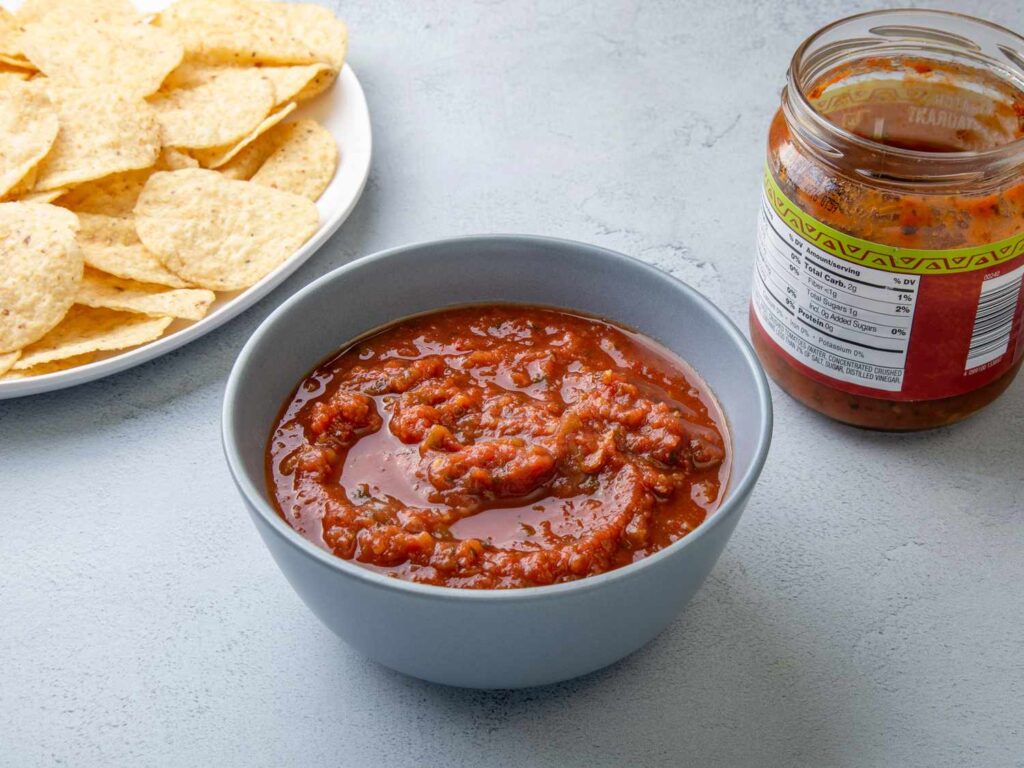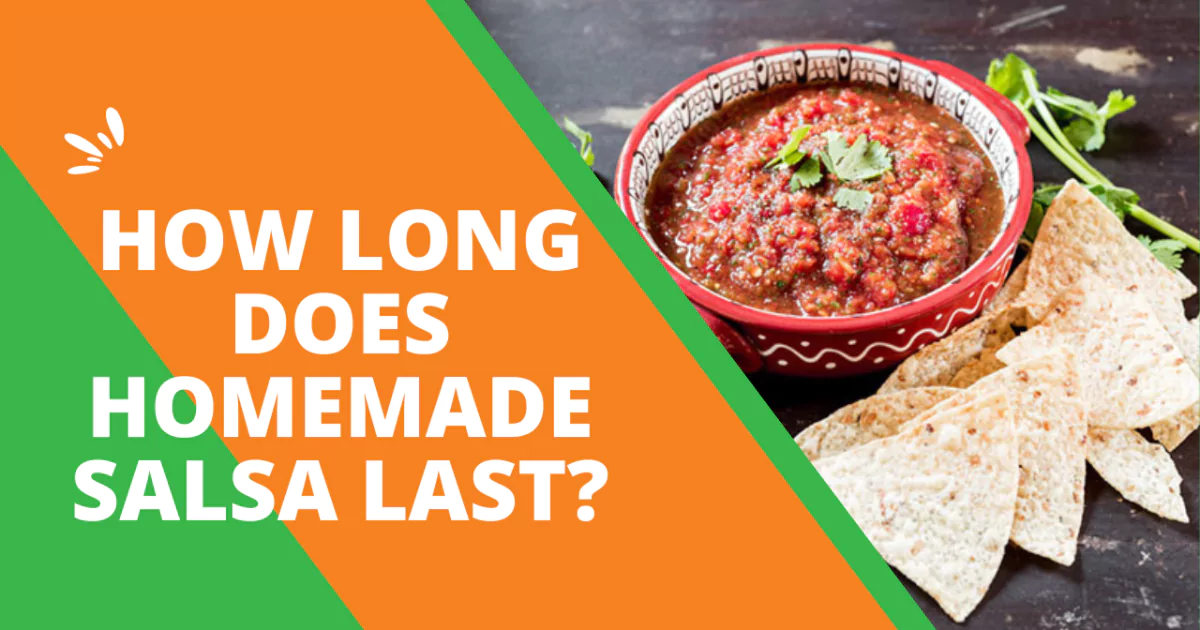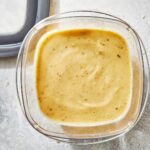Homemade salsa is a popular and versatile condiment that can add flavor to various dishes. Whether you enjoy it as a dip with tortilla chips, a topping for tacos, or a sauce for grilled meats, homemade salsa is a delicious addition to any meal. However, like any perishable food item, knowing how long homemade salsa can last before it spoils is essential.
Also Read : What Vegetables Should Not Be Juiced
In this article, we will explore the factors that affect the shelf life of homemade salsa and provide guidelines on how long you can expect your salsa to stay fresh. We will also discuss proper storage methods and spoilage signs to ensure you can enjoy your homemade salsa safely.
What Exactly Is Salsa?
Salsa is a famous sauce or condiment originating in Latin America, particularly Mexico. It is typically made from a combination of tomatoes, onions, chili peppers, garlic, and various herbs and spices. Depending on personal preference, The ingredients are chopped or blended together to create a chunky or smooth texture.
Salsa can vary in heat level, ranging from mild to extremely spicy, depending on the types and quantities of chili peppers used. It is commonly used as a dip for tortilla chips or a topping for tacos, burritos, quesadillas, and other Mexican dishes. Salsa can also be used as a marinade or flavor enhancer for meats, seafood, and vegetables. Its vibrant flavors and versatility have made it a beloved condiment worldwide.
Main Types Of Salsa
There are numerous variations of salsa, each with unique ingredients and preparation methods.
Salsa Roja
Salsa roja, also known as red salsa, is one of the most common types of salsa. It is typically made with tomatoes as the base ingredient, which gives it a rich red color. Other common elements include onions, garlic, chili peppers (such as jalapeños or serranos), cilantro, and lime juice. Salsa roja can range from mild to spicy, depending on the type and amount of chili peppers used. It is often used as a dipping sauce for tortilla chips or a topping for tacos, enchiladas, and other Mexican dishes.
Salsa Verde
Salsa verde, or green salsa, is another popular variety characterized by its vibrant green color. Unlike salsa roja, salsa verde is made with tomatillos as the primary ingredient. Tomatillos are small green fruits resembling unripe tomatoes with a tangy flavor. Other common ingredients in salsa verde include onions, garlic, chili peppers (such as jalapeños or poblanos), cilantro, and lime juice. Salsa verde has a slightly tart and refreshing taste and pairs well with grilled meats, seafood, and enchiladas.
Pico de Gallo
Pico de gallo, also known as salsa fresca or salsa cruda, is a chunky salsa that is typically made with fresh ingredients. It consists of diced tomatoes, onions, jalapeños or serrano peppers, cilantro, lime juice, and salt. Pico de gallo is often served as a condiment or topping for various dishes, including tacos, grilled meats, and salads. It provides a fresh, tangy flavor that compliments many Mexican and Tex-Mex dishes.
Salsa Negra
Salsa negra, or black salsa, is a lesser-known type of salsa originating from the Mexico Oaxaca region. It gets its dark color from the charred or roasted ingredients used in its preparation. Standard components include dried chili peppers (such as pasilla or ancho), garlic, onions, oil, and sometimes tomatoes. Salsa negra has a smoky and slightly sweet flavor profile, making it a great accompaniment to grilled meats, quesadillas, or tamales.
Is There A Difference Between Homemade And Jarred Salsa?

Yes, there is a difference between homemade and jarred salsa. Homemade salsa is typically made from fresh ingredients that are chopped or blended to create a flavorful and customizable dip. It allows for control over the elements used, such as the type and ripeness of tomatoes, the level of spiciness, and the addition of other vegetables or herbs. Homemade salsa often has a vibrant and chunky texture, with a balance of flavors that can be adjusted to personal preference.
On the other hand, jarred salsa is commercially produced and undergoes a different process. It is usually made from cooked or processed ingredients, including canned tomatoes, onions, peppers, and spices. Jarred salsa often has a smoother consistency and a more uniform flavor profile. While it may be convenient and have a longer shelf life, it may need more freshness and complexity of homemade salsa.
How Long Does An Open Jar Of Salsa Last In The Fridge?
An open jar of salsa can last in the fridge for approximately 1 to 2 weeks. However, it is essential to note that the exact shelf life may vary depending on various factors, such as the brand, ingredients, and storage conditions. It is crucial to check the label or packaging for the manufacturer’s instructions or recommendations.
Additionally, proper storage practices are essential to ensure the salsa remains fresh for as long as possible. This includes tightly sealing the jar after each use, storing it at a consistent temperature below 40°F (4°C), and avoiding cross-contamination using clean utensils when scooping out salsa. If there are any signs of spoilage, such as an off smell, mold growth, or changes in texture or color, it is best to discard the salsa.
What Are The Signs That Salsa Has Gone Bad?
Several signs indicate salsa has gone wrong, and it is essential to be aware of these signs to avoid consuming spoiled salsa.
Mold or discoloration
One of the most apparent signs that salsa has gone wrong is the presence of mold or discoloration. If you notice any fuzzy green, black, or white spots on the surface of the salsa, it is a clear indication that it has spoiled. Additionally, if the salsa has changed in color and appears darker or duller than usual, it may indicate spoilage.
Foul odor
Another sign that salsa has gone wrong is a foul or off-putting odor. Fresh salsa should have a pleasant aroma that is characteristic of its ingredients. However, if you detect a strong, sour, or rotten smell from the salsa, it is likely spoiled and should not be consumed.
Texture changes
Spoiled salsa may also change the texture. If you notice that the salsa has become excessively watery or slimy, it is a sign that bacteria or other microorganisms have started to grow in it. Additionally, if the salsa has become overly thick or clumpy, it may indicate spoilage.
How Long Is Homemade Salsa With Vinegar Good For In The Fridge?
Homemade salsa with vinegar can typically be stored in the refrigerator for 1 to 2 weeks. However, it is essential to note that the exact shelf life may vary depending on the specific ingredients used and the storage conditions. Vinegar, commonly used in homemade salsa as a preservative, helps extend its shelf life by inhibiting the growth of bacteria. Proper storage is crucial to maintain the freshness and quality of homemade salsa with vinegar. It should be stored in an airtight container or jar to prevent air exposure, which can lead to spoilage.
Additionally, it is recommended to keep the salsa refrigerated at a temperature below 40°F (4°C) to slow down bacterial growth. If any signs of spoilage, such as mold growth, off odor, or unusual texture, are observed, it is best to discard the salsa. Always use your best judgment and rely on visual and sensory cues when determining the freshness and safety of homemade salsa with vinegar.
How Long Does Cooked Salsa Last In The Fridge?
Cooked salsa can last in the fridge for about 5 to 7 days. It is essential to store it properly in an airtight container to maintain its freshness and prevent any contamination. The shelf life of cooked salsa can vary depending on various factors, such as the ingredients used, the cooking method, and the storage conditions. Salsa may spoil more quickly if it contains perishable ingredients like fresh tomatoes or onions.
Additionally, if the salsa has been left out at room temperature for an extended period or has been contaminated with utensils or hands that are not clean, it may also spoil faster. It is crucial to use your judgment and inspect the salsa for any signs of spoilage, such as an off smell, mold growth, or changes in texture or color. If you notice any of these signs, it is best to discard the salsa to avoid the risk of foodborne illness.
How Long Is Store-Bought Salsa Good For After Opening?
Store-bought salsa is typically good for about 7 to 10 days after opening as long as it is appropriately stored in the refrigerator. It is essential to check the label for specific instructions or recommendations from the manufacturer regarding storage and shelf life.
Once opened, salsa should be kept in an airtight container to prevent contamination and maintain its freshness. Exposure to air can lead to the growth of bacteria, which can cause foodborne illnesses.
Additionally, using clean utensils when scooping salsa out of the jar is crucial to avoid introducing contaminants. It is worth noting that the quality and taste of salsa may deteriorate over time, so it is best to consume it within the recommended time frame.
How Long Is Tostitos Salsa Good For In The Fridge After Opening?
After opening, Tostitos salsa can typically be stored in the refrigerator for up to 2 weeks. It is important to note that the exact shelf life may vary depending on various factors, such as the specific type of salsa, storage conditions, and the presence of any preservatives. To ensure the salsa remains fresh for as long as possible, store it in an airtight container and keep it refrigerated below 40°F (4°C).
Additionally, before consuming, it is crucial to check for any signs of spoilage, such as an off smell, mold growth, or changes in texture or color. It is always best to refer to the product’s packaging or contact the manufacturer for specific information regarding the shelf life of Tostitos salsa after opening.
How Long Does Jarred Salsa Last After Opening?
Jarred salsa typically lasts 1-2 weeks after opening if stored properly in the refrigerator. The exact shelf life may vary depending on the brand and specific ingredients used in the salsa. It is essential to check the label or packaging for any detailed instructions or recommendations the manufacturer provides.
Once opened, it is crucial to keep the salsa refrigerated at all times to prevent bacterial growth and maintain its quality. Additionally, using clean utensils when scooping out salsa is advisable to avoid introducing contaminants that could shorten its shelf life. If there are any signs of spoilage, such as an off smell, mold growth, or changes in texture or color, it is best to discard the salsa immediately.
FAQs
How Long Can You Store Salsa In The Pantry?
Salsa can be stored in the pantry for approximately 1 to 2 years if unopened and up to 1 week if opened and refrigerated.
What Happens If You Eat Bad Salsa?
You may experience symptoms such as food poisoning, stomach cramps, diarrhea, and vomiting when eating lousy salsa. It is essential to seek medical attention if these symptoms persist or worsen.
When To Throw Out A Jar Of Salsa?
When determining whether to throw out a jar of salsa, it is essential to consider the expiration date, signs of spoilage such as mold or off smells, and any changes in texture or taste.
How Long Do Store-Shelf Commercially-Jarred Options Last?
Store-shelf commercially-jarred options can last for varying durations depending on the specific product, but generally, they have a shelf life of several months to a few years.
Why Is Salsa The Perfect Condiment?
Salsa is the perfect condiment due to its versatility, as it can be used as a dip, topping, or ingredient in various dishes, and its combination of flavors adds depth and excitement to any meal.
Can You Freeze Homemade Salsa?
Yes, you can freeze homemade salsa. Freezing salsa can help preserve its freshness and flavors for an extended period.
Conclusion
In conclusion, the shelf life of homemade salsa can vary depending on various factors, such as the ingredients used, the storage conditions, and the preparation method. However, on average, homemade salsa can last 5 to 7 days when stored properly in the refrigerator.
It is important to note that homemade salsa contains fresh ingredients like tomatoes, onions, peppers, and herbs, which are prone to spoilage due to their high water content and natural enzymes. Therefore, handling and storing homemade salsa correctly is crucial to ensure its freshness and prevent any potential foodborne illnesses.






